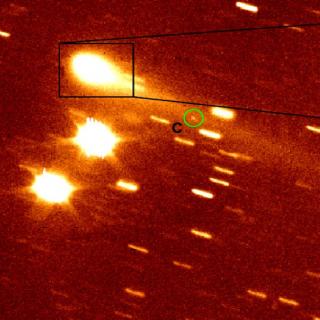Bibcode
de la Fuente Marcos, R.; de León, J.; de la Fuente Marcos, C.; Licandro, J.; Serra-Ricart, M.; Cabrera-Lavers, A.
Referencia bibliográfica
Astronomy and Astrophysics
Fecha de publicación:
2
2023
Revista
Número de citas
14
Número de citas referidas
9
Descripción
Context. The near-Earth orbital space is shared by natural objects and space debris that can be temporarily captured in geocentric orbits. Short-term natural satellites are often called mini-moons. Reflectance spectroscopy can determine the true nature of transient satellites because the spectral signatures of spacecraft materials and near-Earth asteroids (NEAs) are different. The recently discovered object 2022 NX1 follows an Earth-like orbit that turns it into a recurrent but ephemeral Earth companion. It has been suggested that 2022 NX1 could have an artificial origin or be lunar ejecta.
Aims: Here, we use reflectance spectroscopy and N-body simulations to determine the nature and actual origin of 2022 NX1.
Methods: We carried out an observational study of 2022 NX1, using the OSIRIS camera spectrograph at the 10.4 m Gran Telescopio Canarias, to derive its spectral class. N-body simulations were also performed to investigate how it reached NEA space.
Results: The reflectance spectrum of 2022 NX1 is neither compatible with an artificial origin nor lunar ejecta; it is also different from the V type of the only other mini-moon with available spectroscopy, 2020 CD3. The visible spectrum of 2022 NX1 is consistent with that of a K-type asteroid, although it could also be classified as an Xk type. Considering typical values of the similar albedo of both K-type and Xk-type asteroids and its absolute magnitude, 2022 NX1 may have a size range of 5 to 15 m. We confirm that 2022 NX1 inhabits the rim of Earth's co-orbital space, the 1:1 mean-motion resonance, and experiences recurrent co-orbital engagements of the horseshoe-type and mini-moon events.
Conclusions: The discovery of 2022 NX1 confirms that mini-moons can be larger than a few meters and also that they belong to a heterogeneous population in terms of surface composition.
Aims: Here, we use reflectance spectroscopy and N-body simulations to determine the nature and actual origin of 2022 NX1.
Methods: We carried out an observational study of 2022 NX1, using the OSIRIS camera spectrograph at the 10.4 m Gran Telescopio Canarias, to derive its spectral class. N-body simulations were also performed to investigate how it reached NEA space.
Results: The reflectance spectrum of 2022 NX1 is neither compatible with an artificial origin nor lunar ejecta; it is also different from the V type of the only other mini-moon with available spectroscopy, 2020 CD3. The visible spectrum of 2022 NX1 is consistent with that of a K-type asteroid, although it could also be classified as an Xk type. Considering typical values of the similar albedo of both K-type and Xk-type asteroids and its absolute magnitude, 2022 NX1 may have a size range of 5 to 15 m. We confirm that 2022 NX1 inhabits the rim of Earth's co-orbital space, the 1:1 mean-motion resonance, and experiences recurrent co-orbital engagements of the horseshoe-type and mini-moon events.
Conclusions: The discovery of 2022 NX1 confirms that mini-moons can be larger than a few meters and also that they belong to a heterogeneous population in terms of surface composition.
Based on observations made with the Gran Telescopio Canarias (GTC) telescope, in the Spanish Observatorio del Roque de los Muchachos of the Instituto de Astrofísica de Canarias (program ID GTC23-22A).
Proyectos relacionados

Pequeños Cuerpos del Sistema Solar
Este Proyecto estudia las propiedades físicas y composicionales de los llamados pequeños cuerpos del Sistema Solar, que incluyen asteroides, objetos helados y cometas. Entre los grupos de mayor interés destacan los objetos trans-neptunianos (TNOs), incluyendo los objetos más lejanos detectados hasta la fecha (Extreme-TNOs o ETNOs); los cometas, y
Julia de
León Cruz